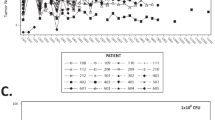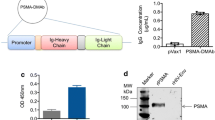Abstract
Prostate specific antigen (PSA) is a likely immunotherapeutic target antigen for prostate cancer, the second leading cause of cancer-related death in American men. Previously, we demonstrated that attenuated strains of Listeria monocytogenes (Lm) can be used as effective vaccine vectors for delivery of tumor antigens causing regression of established tumors accompanied by strong immune responses toward these antigens in murine models of cancer. In the present study, we have developed and characterized a recombinant live attenuated L. monocytogenes/PSA (Lm–LLO–PSA) vaccine with potential use for the treatment of pCa. Human PSA gene was cloned into and expressed by an attenuated Lm strain. This recombinant bacterial vaccine, Lm–LLO–PSA was tested for stability, virulence, immunogenicity and anti-tumor effects in a murine model for pCa. Immunization with Lm–LLO–PSA was shown to lower the number of tumor infiltrating T regulatory cells and cause complete regression of over 80% of tumors formed by an implanted genetically modified mouse prostate adenocarcinoma cell line, which expressed human PSA. Lm–LLO–PSA was immunogenic in C57BL/6 mice and splenocytes from mice immunized with Lm–LLO–PSA showed significantly higher number of IFN-γ secreting cells over that of the naïve animals in response to a PSA H2Db-specific peptide, as measured by both, ELISpot and intracellular cytokine staining. In addition, using a CTL assay we show that the T cells specific for PSA were able to recognize and lyse PSA-peptide pulsed target cells in vitro. In a comparison study with two other PSA-based vaccines (a pDNA and a vaccinia vaccine), Lm–LLO–PSA was shown to be more efficacious in regressing established tumors when used in a homologues prime/boost regimen. Together, these results indicate that Lm–LLO–PSA is a potential candidate for pCa immunotherapy and should be further developed.










Similar content being viewed by others
References
Jemal A et al (2007) Cancer statistics, 2007. CA Cancer J Clin 57(1):43–66
Katz MH, McKiernan JM (2007) High-risk, clinically localized prostate cancer: is monotherapy adequate? Rev Urol 9(Suppl 2):S19–S27
Bhardwaj N (2007) Harnessing the immune system to treat cancer. J Clin Invest 117(5):1130–1136
Tricoli JV, Schoenfeldt M, Conley BA (2004) Detection of prostate cancer and predicting progression: current and future diagnostic markers. Clin Cancer Res 10(12 Pt 1):3943–3953
Watt KW et al (1986) Human prostate-specific antigen: structural and functional similarity with serine proteases. Proc Natl Acad Sci USA 83(10):3166–3170
Stamey TA et al (1987) Prostate-specific antigen as a serum marker for adenocarcinoma of the prostate. N Engl J Med 317(15):909–916
Cunha AC et al (2006) Tissue-specificity of prostate specific antigens: comparative analysis of transcript levels in prostate and non-prostatic tissues. Cancer Lett 236(2):229–238
Arlen PM et al (2006) A randomized phase II study of concurrent docetaxel plus vaccine versus vaccine alone in metastatic androgen-independent prostate cancer. Clin Cancer Res 12(4):1260–9
Heiser A et al (2002) Autologous dendritic cells transfected with prostate-specific antigen RNA stimulate CTL responses against metastatic prostate tumors. J Clin Invest 109(3):409–417
Marshall DJ et al (2005) Induction of Th1-type immunity and tumor protection with a prostate-specific antigen DNA vaccine. Cancer Immunol Immunother 54(11):1082–1094
Noguchi M et al (2003) Induction of cellular and humoral immune responses to tumor cells and peptides in HLA-A24 positive hormone-refractory prostate cancer patients by peptide vaccination. Prostate 57(1):80–92
Roos AK et al (2005) Induction of PSA-specific CTLs and anti-tumor immunity by a genetic prostate cancer vaccine. Prostate 62(3):217–23
Gunn GR et al (2001) Two Listeria monocytogenes vaccine vectors that express different molecular forms of human papilloma virus-16 (HPV-16) E7 induce qualitatively different T cell immunity that correlates with their ability to induce regression of established tumors immortalized by HPV-16. J Immunol 167(11):6471–6479
Pan ZK et al (1995) Regression of established tumors in mice mediated by the oral administration of a recombinant Listeria monocytogenes vaccine. Cancer Res 55(21):4776–4779
Singh R et al (2005) Fusion to Listeriolysin O and delivery by Listeria monocytogenes enhances the immunogenicity of HER-2/neu and reveals subdominant epitopes in the FVB/N mouse. J Immunol 175(6):3663–3673
Pamer EG (2004) Immune responses to Listeria monocytogenes. Nat Rev Immunol 4(10):812–823
Foster BA et al (1997) Characterization of prostatic epithelial cell lines derived from transgenic adenocarcinoma of the mouse prostate (TRAMP) model. Cancer Res 57(16):3325–3330
Sambrook J, Russell D (2001) Molecular cloning: a laboratory manual (3-Volume Set) 3 Lab edition. Cold Spring Harbor Laboratory Press, Cold Spring Harbor
Peters C, Paterson Y (2003) Enhancing the immunogenicity of bioengineered Listeria monocytogenes by passaging through live animal hosts. Vaccine 21(11–12):1187–1194
Pavlenko M et al (2005) Identification of an immunodominant H-2D(b)-restricted CTL epitope of human PSA. Prostate 64(1):50–59
Blomberg K et al (1986) Europium-labelled target cells in an assay of natural killer cell activity. II. A novel non-radioactive method based on time-resolved fluorescence. significance and specificity of the method. J Immunol Methods 92(1):117–123
Decatur AL, Portnoy DA (2000) A PEST-like sequence in listeriolysin O essential for Listeria monocytogenes pathogenicity. Science 290(5493):992–995
Lety MA et al (2001) Identification of a PEST-like motif in listeriolysin O required for phagosomal escape and for virulence in Listeria monocytogenes. Mol Microbiol 39(5):1124–1139
Schnupf P, Portnoy DA, Decatur AL (2006) Phosphorylation, ubiquitination and degradation of listeriolysin O in mammalian cells: role of the PEST-like sequence. Cell Microbiol 8(2):353–364
Leimeister-Wachter M et al (1990) Identification of a gene that positively regulates expression of listeriolysin, the major virulence factor of Listeria monocytogenes. Proc Natl Acad Sci USA 87(21):8336–8340
Stier EM, Mandal M, Lee KD (2005) Differential cytosolic delivery and presentation of antigen by listeriolysin O-liposomes to macrophages and dendritic cells. Mol Pharm 2(1):74–82
Bullock TN, Mullins DW, Engelhard VH (2003) Antigen density presented by dendritic cells in vivo differentially affects the number and avidity of primary, memory, and recall CD8+ T cells. J Immunol 170(4):1822–1829
Nitcheu-Tefit J et al (2007) Listeriolysin O expressed in a bacterial vaccine suppresses CD4+CD25high regulatory T cell function in vivo. J Immunol 179(3):1532–1541
Roos AK et al (2006) Enhancement of cellular immune response to a prostate cancer DNA vaccine by intradermal electroporation. Mol Ther 13(2):320–327
Tuteja R et al (2000) Augmentation of immune responses to hepatitis E virus ORF2 DNA vaccination by codelivery of cytokine genes. Viral Immunol 13(2):169–178
Hodge JW et al (1995) A recombinant vaccinia virus expressing human prostate-specific antigen (PSA): safety and immunogenicity in a non-human primate. Int J Cancer 63(2):231–237
Lamikanra A et al (2001) Regression of established human papillomavirus type 16 (HPV-16) immortalized tumors in vivo by vaccinia viruses expressing different forms of HPV-16 E7 correlates with enhanced CD8(+) T-cell responses that home to the tumor site. J Virol 75(20):9654–9664
Lizee G et al (2006) Improving antitumor immune responses by circumventing immunoregulatory cells and mechanisms. Clin Cancer Res 12(16):4794–803
Yu P, Fu YX (2006) Tumor-infiltrating T lymphocytes: friends or foes? Lab Invest 86(3):231–245
Hussain SF, Paterson Y (2004) CD4+CD25+ regulatory T cells that secrete TGFbeta and IL-10 are preferentially induced by a vaccine vector. J Immunother (1997) 27(5):339–346
Nishimura T et al (2000) The critical role of Th1-dominant immunity in tumor immunology. Cancer Chemother Pharmacol 46(Suppl):S52–S61
Konig R et al (2002) The role of CD4 in regulating homeostasis of T helper cells. Immunol Res 25(2):115–130
Singh R, Paterson Y (2007) In the FVB/N HER-2/neu transgenic mouse both peripheral and central tolerance limit the immune response targeting HER-2/neu induced by Listeria monocytogenes-based vaccines. Cancer Immunol Immunother 56(6):927–38
Souders NC et al (2007) Listeria-based vaccines can overcome tolerance by expanding low avidity CD8+ T cells capable of eradicating a solid tumor in a transgenic mouse model of cancer. Cancer Immun 7:2
Gulley J et al (2002) Phase I study of a vaccine using recombinant vaccinia virus expressing PSA (rV-PSA) in patients with metastatic androgen-independent prostate cancer. Prostate 53(2):109–117
Pavlenko M et al (2004) A phase I trial of DNA vaccination with a plasmid expressing prostate-specific antigen in patients with hormone-refractory prostate cancer. Br J Cancer 91(4):688–694
Schafer R et al (1992) Induction of a cellular immune response to a foreign antigen by a recombinant Listeria monocytogenes vaccine. J Immunol 149(1):53–59
DiPaola RS et al (2006) A phase I trial of pox PSA vaccines (PROSTVAC-VF) with B7-1, ICAM-1, and LFA-3 co-stimulatory molecules (TRICOM) in patients with prostate cancer. J Transl Med 4:1
Barrou B et al (2004) Vaccination of prostatectomized prostate cancer patients in biochemical relapse, with autologous dendritic cells pulsed with recombinant human PSA. Cancer Immunol Immunother 53(5):453–60
Su Z et al (2005) Telomerase mRNA-transfected dendritic cells stimulate antigen-specific CD8+ and CD4+ T cell responses in patients with metastatic prostate cancer. J Immunol 174(6):3798–807
Rini BI et al (2006) Combination immunotherapy with prostatic acid phosphatase pulsed antigen-presenting cells (provenge) plus bevacizumab in patients with serologic progression of prostate cancer after definitive local therapy. Cancer 107(1):67–74
Author information
Authors and Affiliations
Corresponding author
Rights and permissions
About this article
Cite this article
Shahabi, V., Reyes-Reyes, M., Wallecha, A. et al. Development of a Listeria monocytogenes based vaccine against prostate cancer. Cancer Immunol Immunother 57, 1301–1313 (2008). https://doi.org/10.1007/s00262-008-0463-z
Received:
Accepted:
Published:
Issue Date:
DOI: https://doi.org/10.1007/s00262-008-0463-z




